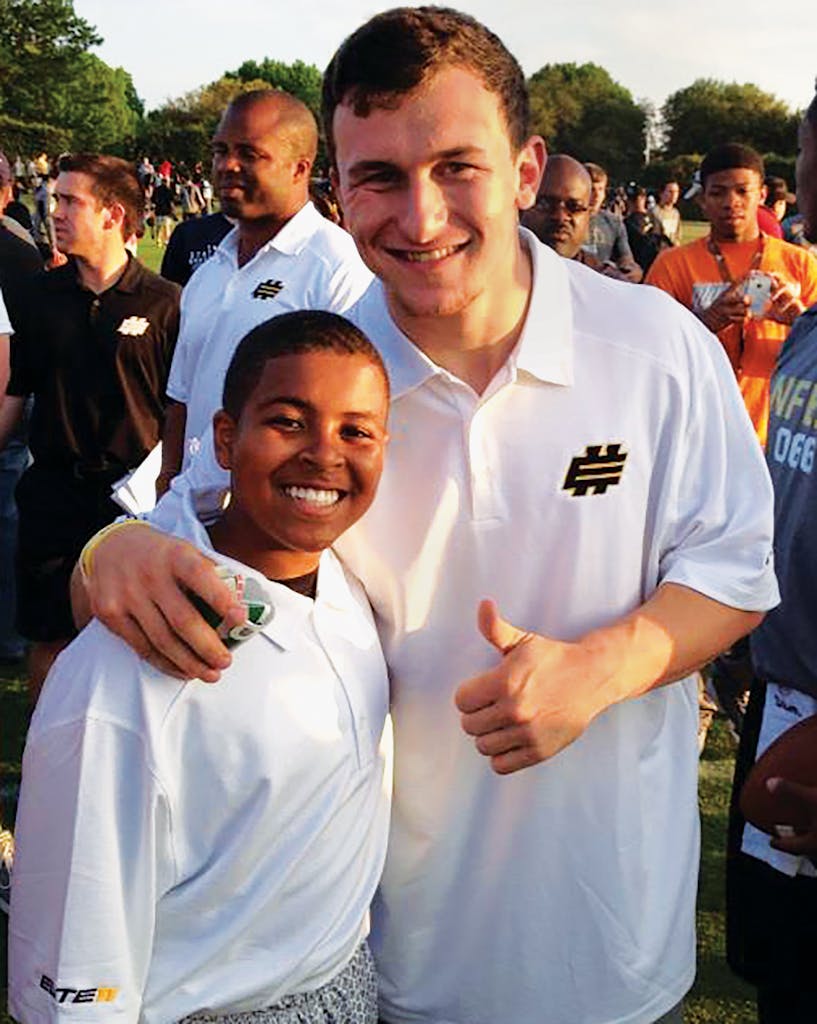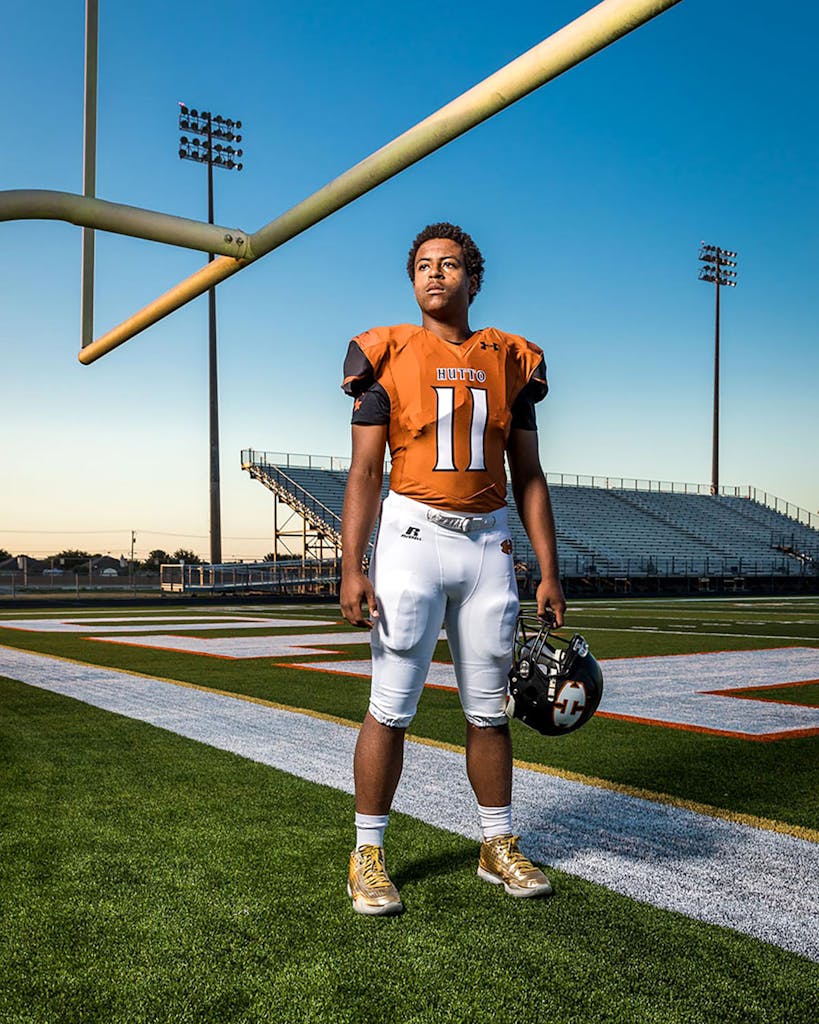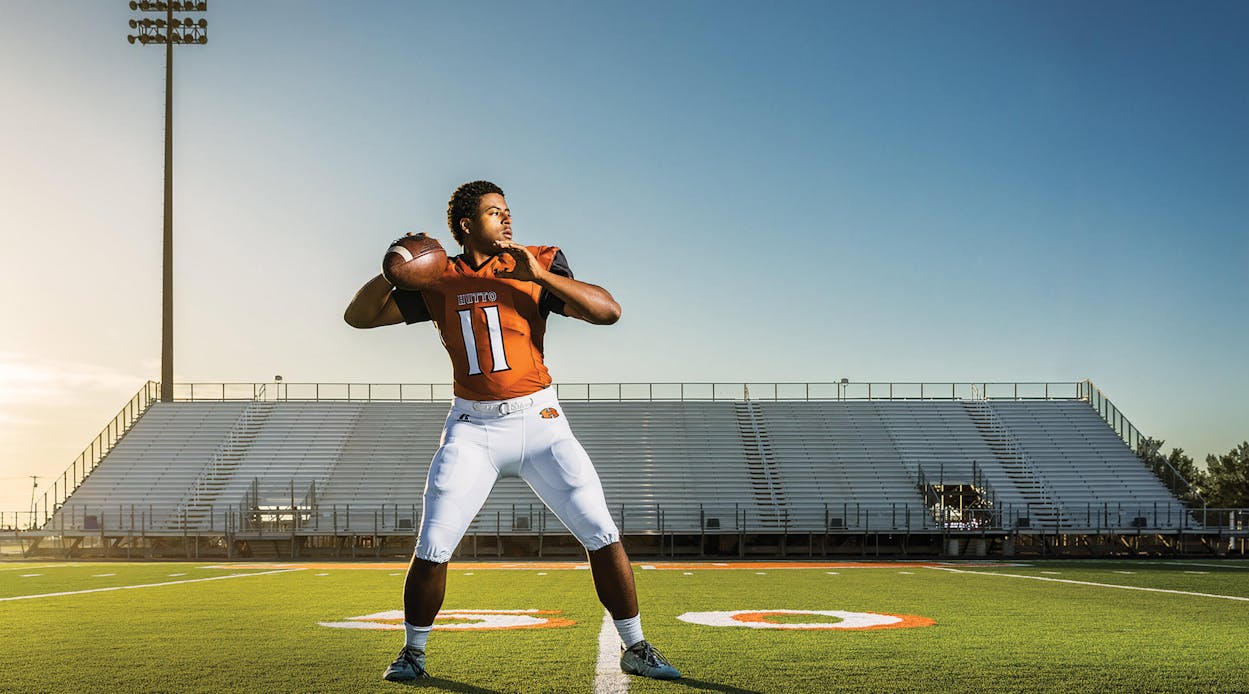There is no off-season in Texas football, so it was no surprise that on a hot early July morning, Chase Griffin, the rising junior quarterback of the Hutto Hippos, was already looking sharp, slinging passes around his high school’s empty turf field. The previous weekend, Griffin had led Hutto to a first-place finish in the consolation bracket of the state seven-on-seven football tournament, and he had spent much of the month of June juggling his commitments for Hutto with trips to college football camps, flying around the country (University of North Carolina, Southern Cal, Cal, Stanford) and driving around the state (UT, A&M, TCU, Houston) to showcase his skills for Division I coaches. Chase’s jam-packed early summer had followed three weeks of the Hippos’ spring football practice, which had followed Chase’s first varsity season, in which he’d thrown for 3,056 yards and 31 touchdowns and been named the All–Central Texas Newcomer of the Year by the Austin American-Statesman. (He also proudly maintains a 4.0 GPA and plans to join the robotics club this fall.) Now, at Hutto Memorial Stadium, Chase was looking for his next edge, tweaking the “kinematic sequence” of his throwing motion under the tutelage of Trenton Kirklin, an ebullient 25-year-old who serves as offensive coordinator at New Braunfels’s Canyon High School and is one of Chase’s three private quarterback coaches.
“Focus on your ankle eye getting to me,” Kirklin said, referring to the path of Chase’s back foot as the quarterback threw the football. Chase made a tiny adjustment and zipped a pass across the field to his coach. Kirklin looked down at his hands and grinned. “That one had some juice on it!”
Next, Kirklin fixated on the alignment of Chase’s front foot. “This is what Brady does,” Kirklin said, pointing his front foot toward his target in the style of the New England Patriots star. “And this is what Carson does.” He adjusted the same foot to the more closed position favored by Philadelphia Eagles quarterback Carson Wentz.
Chase looked on intently, an eager student registering the information. (“My wife had Chase do Suzuki violin,” his father, Will Griffin, would tell me later. “He learned how to concentrate.”)

Soon, Chase was rehearsing his throws at a fast cadence. “Hole shot,” he called out to himself, pivoting his feet and throwing across his body to complete a pass to Kirklin on the far side of the field. “Dig,” Chase intoned, hitting Kirklin in the chest as the coach sprinted across the field.
Chase finished with deep routes, launching the ball on 40-yard parabolas. His first pass sailed into Kirklin’s outstretched hands. The second fluttered short, and the coach had to clamber a few steps back to catch it. “Speed up your foot strike. I guarantee it’ll be farther,” Kirklin said. Chase followed his advice, and the next throw traveled an additional four yards. “That’s pretty good, dude,” Will said to his son. He turned to me. “If you spend two hours and get better at one throw, it’s worth it. It could be a game winner.”
For most of football’s history, quarterback development amounted to finding a tall, athletic kid who could throw and leaving him to figure out the rest. There were no private quarterback coaches. There was little education in the finer points of throwing mechanics. Footwork was rarely given more than a cursory glance. That era now seems almost prehistoric.
Google “private quarterback coach” and you’ll find pages and pages of links for reputed experts around the country. Fees range from a children’s-piano-teacher-like $50-per-hour to a corporate-lawyer-billable-hours rate of $600 or more. The industry first took off in California, but over the past several years it has taken deep root in Texas. Now, if you live in the Dallas area, you can take your aspiring Dak Prescott to study quarterbacking with former Texas A&M star Kevin Murray or recent SMU signal caller Kyle Padron or former Green Bay Packers backup Craig Nall. In Houston, there’s former NFLer Mike Quinn and ex-ESPN analyst Sean Salisbury and Texas A&M’s career passing leader, Jerrod Johnson.

This growing cottage industry isn’t just a fad for crazy Pop Warner parents. While football may be confronting existential concerns over brain injuries, the quarterback position has never been more glamorous, consequential, or harder to play. Three decades ago, most young quarterbacks were primarily responsible for handing off the ball to their running backs. Now, wide-open, pass-centric offenses are the rule at every level of the game, and quarterback play has become the single most crucial factor in winning or losing. A quarterback who is not spending countless hours mastering his craft is about as likely to lead an elite high school team, to say nothing of a big-time college or pro squad, as a practice-averse concert pianist is of playing at Carnegie Hall.
Chase Griffin, like many youth quarterbacks, began taking lessons with a quarterback coach before he had ever played quarterback. Chase’s parents hadn’t been enthusiastic about the prospect of his playing tackle football, and when they finally allowed it, Will told his then ten-year-old son that he had to be the quarterback. (“You get beat up less as a QB,” Will reasoned.) Will has an impressive résumé—Harvard Law School, a business partnership with music mogul Russell Simmons, and his current gig running the television service Hip-Hop on Demand—but his own football career had ended before tenth grade, and he knew his son would be better off learning from others.
The summer before Chase’s first season of tackle football, Will hired Jeff Blake, a thirteen-year NFL veteran who lives in Austin, to teach Chase the basics of the position. The next year, Will sought out the San Diego–based quarterback coach George Whitfield Jr., whom the Griffins had first seen on ESPN training future Carolina Panthers star Cam Newton for the NFL combine.
At the time, Whitfield’s roster of pupils included both Newton and Pittsburgh Steelers star Ben Roethlisberger, but the quarterback trainer made time for Chase. During his first session with the young Texan, Whitfield told Will, “I want to train him all the way up.”

Whitfield opened doors for Chase that few young quarterbacks short of the scions of all-time NFL greats would have ever even known existed. When Chase was eleven, former NFL quarterback Trent Dilfer invited him to be a ball boy at the Elite 11, the most prestigious high-school-quarterback showcase in the country. When Chase was thirteen, Johnny Manziel, another Whitfield client, posted a picture of the two quarterbacks posing together on Instagram with the hashtag #NextBigThing. A few months after Manziel’s Instagram post, ESPN published a feature-length profile of Chase under the headline “The QB Most Likely to Succeed.” (“He’s a ninety-ninth-percentile test-taker and chamber orchestra violinist who’s already plotting to one day run a water purification startup, then maybe run for president,” the article gushed.) Chase continues to work out with Whitfield, sometimes dropping by to share a workout with the likes of Vince Young or Tampa Bay Buccaneers starter Jameis Winston.
As we sat down for lunch, Will pulled out his iPhone and showed me his son’s Instagram feed. “He’ll get, like, twenty-five, thirty QBs,” Will told me, pointing to the likes under one of Chase’s posts. “Look, [Texas Longhorns freshman] Sam Ehlinger, [New York Giants backup] Davis Webb, [Oakland Raiders backup] Connor Cook.”
Chase sat in silence next to his father, betraying little excitement. He was used to his dad taking on the role of good-natured hype man, and he seemed content to let him do the boasting. I wondered what becoming the adopted little brother of so many big-time quarterbacks meant to him. Did it give him an extra boost?
“I definitely appreciate it, but it doesn’t give me confidence,” he said. “The work itself gives me my confidence. I feel like no one is doing more quality work than me.”
There’s a touch of irony in the tremendous effort being expended on developing the next generation of Texas quarterbacks: despite the state’s legendary high school football culture, it has been a quarterback wasteland for most of its history. The last Texas-raised quarterback to be enshrined in the NFL Hall of Fame was Y. A. Tittle, a Marshall native who threw his final professional pass in December 1964. From Tittle’s retirement until 2001, when the San Diego Chargers selected an undersized Westlake graduate named Drew Brees in the second round of the NFL draft, the most successful professional quarterback that Texas produced was Tommy Kramer, the pride of San Antonio’s Robert E. Lee High School, who made the Pro Bowl with the Minnesota Vikings in 1986 but spent much of his otherwise unremarkable fourteen years in the NFL battling injuries and earning a reputation for carousing. Over the same period of time, Pennsylvanians watched the Hall of Fame careers of native sons Joe Namath, Joe Montana, Jim Kelly, and Dan Marino.
It’s not as if there was something in the Texas soil that inhibited the growth of top-flight passers. Quarterback play just wasn’t emphasized in the state. Offensive formations tended to feature two- and sometimes three-running-back sets, and running-dominated attacks such as the wishbone were considered the surest paths to victory. Texas coaches at both the high school and college level regarded the forward pass with suspicion if not outright contempt. As University of Texas head coach Darrell Royal famously said, “Three things can happen when you throw the football, and two of them are bad.”
“Growing up in Ohio, I remember you heard the mythology of Texas high school football,” said Oliver Luck, a former Houston Oilers quarterback whose son, Andrew, a graduate of Houston’s Stratford High School, is a three-time NFL Pro Bowler and the Indianapolis Colts’ franchise quarterback. “Texas was Earl Campbell and Billy Sims. It was running backs and linebackers. California was quarterbacks. Ohio and Pennsylvania were a combination of everything.”
Then, slowly, a few innovative coaches began to air it out. In 1972, Kramer set a state record by throwing for 2,588 yards. By 1985, when future Heisman trophy winner Ty Detmer threw for 3,551 yards for San Antonio’s Southwest High School, Kramer’s total seemed passé. Detmer’s father, Sonny, was Southwest’s coach, and he had started using offensive formations that stretched four and even five receivers across the line of scrimmage. The idea was to open up passing lanes—and to pass a lot.
Detmer wasn’t alone. Ronnie Thompson was running his own pass-heavy attack at Jefferson High School, in Port Arthur; Rusty Dowling was doing the same in Mission; and Hal Mumme was installing an early version of the Air Raid offense at Copperas Cove. But still, they were outliers. “Coaches are creatures of habit,” said David Barron, a longtime Houston Chronicle sportswriter and 2011 inductee into the Texas High School Football Hall of Fame. “And they weren’t going to change until someone showed that you could win championships that way.”
When Stephenville High School, under Art Briles, who later became Baylor’s coach, won the state 4A championship with an up-tempo quarterback-centric offense in 1993, the hidebound coaching fraternity began to take notice. Stephenville won again, in 1994. By the mid-aughts, when Todd Dodge, who had played quarterback in Port Arthur under Thompson, won four titles in five years as head coach of Southlake Carroll, even the most conservative coaches clamored to copy his no-huddle, spread attack.
The new offenses depended on adept quarterbacks, and long before private coaching became an industry, Texas installed a system that energized the development of passers: seven-on-seven football. That no-tackling-or-blocking variation of the sport had been played in California since the seventies, but it took a 1996 ruling by the University Interscholastic League for Texas high schools to get in on the action. Soon, almost every high school was fielding a team, and since the official Texas rules dictate that “offensive plays must all be passes!” (the exclamation point is official too), quarterbacks were getting more reps than they’d ever dreamed of before.
The increasing emphasis on quarterback play in high school resulted in a surge in Texas quarterbacks who excelled in the professional ranks. When Brees rose to the top of the Chargers’ depth chart, in 2002, he was one of just three Texas-bred quarterbacks that season to start an NFL game. (The others were less-than-all-world signal callers Tommy Maddox and Koy Detmer, Ty’s younger brother.) Jump to 2017 and Texas quarterbacks own the league, with Brees and Luck joined by Detroit’s Matthew Stafford (from Highland Park), Cincinnati’s Andy Dalton (Katy), the New York Jets’ Josh McCown (Jacksonville), Miami’s injured starter Ryan Tannehill (Big Spring), and Oakland’s Derek Carr (a California native who played three years of high school football in Sugar Land). That’s not even mentioning the many Texas-bred backups, among them former UT-Austin star Colt McCoy, or the three legends of Texas college football (Young, Manziel, and Robert Griffin III), who are still circling the league, hoping for another chance.
Such stars may be only the first wave in the era of the great Texas quarterback. Last year, Nick Gerber, of Levelland, threw for a state record 5,617 yards and 77 touchdowns, and two other quarterbacks posted passing seasons that rank in the top five of all time for yards. Simply putting up big numbers isn’t an indicator of future success, but when I spoke with Graham Harrell, the offensive coordinator at the University of North Texas, who is only 32 and just a decade removed from his record-setting days as a quarterback at Ennis High School and Texas Tech, he told me that when he watches recruiting videos now, he sees guys who are “leaps and bounds” ahead of where he was.
“A lot of people recruited me,” Harrell said, “but when I see old clips of myself, I don’t know if I would recruit myself anymore. ”
The quarterback-coaching industry offers a tantalizing promise: that if you master the many skills that go into the position, you can maximize your chances of success. Studying with Trenton Kirklin or Jeff Blake or George Whitfield (or all three) is going to make you into a more refined, complete passer. It’s also going to cost a lot of money. Many of the first private quarterback coaching clients were rich kids from Los Angeles, and the industry still favors young passers whose families can afford the help (although ambitious coaches like Kirklin do take on some promising, less privileged clients for drastically reduced rates).

But successful quarterbacking has also always depended as much on intangibles—the steely resolve needed to lead a two-minute drill, say—as on arm strength and flawless mechanics. “Competitiveness. Toughness. Leadership. Resilience. Moxie. Grit. There are all sorts of buzzwords coaches use when it comes to sizing up the man they’d feel most confident flipping the keys of their livelihood to,” writes the college-football reporter Bruce Feldman in his 2014 book The QB: The Making of Modern Quarterbacks. “Of course, none of those traits can be measured with any stopwatch or tape measure, which is a big reason the draft, much like the college recruiting process, is such a crapshoot, especially when it comes to quarterbacks.”
So far, Chase Griffin has received only one college offer, and it’s from Yale, which is both one of the finest universities in the world and a not-quite-first-choice destination for someone with Super Bowl aspirations. (Cal has always been his dream school.) The reason is simple: Chase stands five feet ten inches, diminutive for the position. And unlike other under-six-foot quarterbacks, such as Manziel or Seattle Seahawks star Russell Wilson, Chase doesn’t compensate for his lack of height with once-in-a-generation athletic talent or an almost mutantlike body. (Manziel has size 15 feet. Wilson has huge 10 1/4-inch hands.)
But Chase does have intangibles. For one, he’s smart. “He blew me away with the way he could get up on a whiteboard and talk x’s and o’s and pass-blocking schemes,” Hutto’s head coach, Steve Van Meter, told me. “Chase just lives and breathes it.” And he’s willing to work and work and work.
When I asked Chase what set him apart from other quarterbacks, he focused on another intangible. “I hate losing, I hate being outperformed. When I’m playing a game or I’m at a camp, I’m not going to leave the field in a way that shows that I didn’t want it.”
Kirklin had seen this quality in Chase too. “If you get a group of quarterbacks together, Chase is going to be the alpha,” the coach said—and while solid fundamentals and exhaustive preparation can fuel a certain confidence, swagger is something that not even Whitfield can teach.
Better coaching and more innovative offenses and seven-on-seven football may have created the conditions necessary to develop generations of great passers. Chase has benefited from all of that, and he has distinguished himself as an uncommonly apt pupil, the kind who earns MVPs at college camps and attaboys from established stars. But he’s well aware of the fact that there’s only one way that he can really prove himself to be a great quarterback: by winning, on the field, in the fall.
The Texas QB Evolution
The Pioneer: Y. A. Tittle
An East Texas kid who grew up throwing into a tire swing. Tittle led a Hall of Fame career from 1948 to 1964 that saw him make the All-Pro team four times.
The Gunslinger: Tommy Kramer
The San Antonio native thrived in an era when Texas passers were rare. In his fourteen-year NFL career, he made a Pro Bowl but spent much of the eighties battling injuries.
The Virtuoso: Drew Brees
At only six feet tall, Brees faced doubters throughout his early years. Now 38, the Super Bowl champ and New Orleans Saints hero is a surefire Hall of Famer.
The Superathlete: Patrick Mahomes II
A top MLB prospect before he focused on football at Texas Tech, Mahomes went tenth in this year’s draft and looks like a future star of the Kansas City Chiefs.








